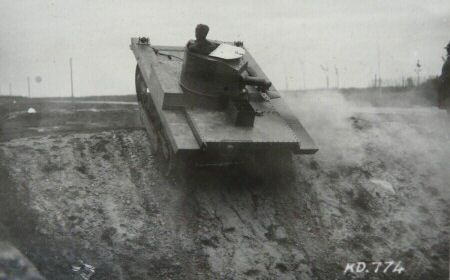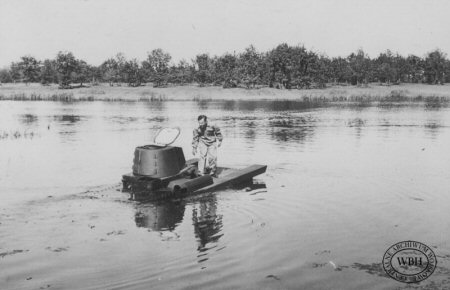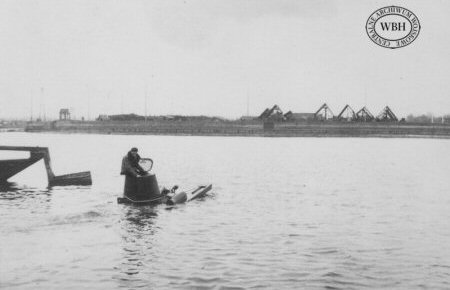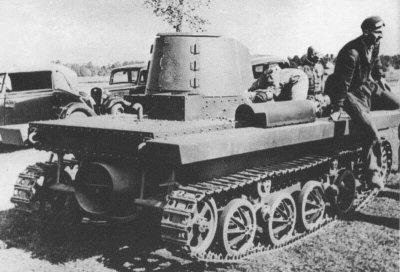|  | |||||
Polish amphibious tank PZInż. 130

| PZInż.130 prototype after its delivery to the Army, 15 August 1937. |
History – Armament and armour – Description – Specifications – Model kits
|  | |||||

| PZInż.130 prototype after its delivery to the Army, 15 August 1937. |
One of the most interesting armoured vehicles designed in Poland was light amphibious reconnaissance tank PZInż. 130, which remained a prototype. It belonged to a family of modern tracked vehicles, developed by Edward Habich in the late 1930s, which also included light reconnaissance tank PZInż. 140 (4TP), an artillery tractor PZInż. 152 and a tank destroyer PZInż. 160, all using unified chassis.
Note: links with dashed underline lead to Wikipedia articles.
 |
| British Vickers Carden-Loyd Amphibious Tank. |
A background of the amphibious tank PZInż. 130 lays in designs of well-known British designers, John Carden and Vivian Loyd. Working for Vickers-Armstrongs, they designed numerous successful light tanks, which were exported to many countries and influenced many other designs in the world. From 1928 they were developing a line of Light Tanks for the British Army, and similar light tanks for export (Vickers Carden-Loyd 4-ton - more on 4TP page). In 1929 they designed export Vickers Carden-Loyd Amphibious Tank. It retained features of 4-ton light tanks, like a paired bogey-type suspension with two wheels per bogey, sprung on leaf springs, an engine placed in the right part of the hull, two men crew and rotating MG-armed turret. The new design introduced a watertight hull of a pontoon shape, and mudguards serving as floats. In water it was driven by a propeller and steered with a ring rudder. It was the first successful amphibious tank design in the world, and the first one produced in series. The British Army did not order this tank eventually, in spite of testing two prototypes A4E11 and A4E12, but small series were built for China (29), the Soviet Union (8), Siam (2), the Netherlands (2 for the Dutch East Indies) and Japan (1). Its influence on other designs was yet bigger. Basing roughly upon its licence, the Soviet Union developed its own line of amphibious tanks: T-33, T-41, T-37 and T-38 – the latter two were mass produced.
 |
 |
| Tests of VCL Amphibious Tank in Poland in 1932. Visible is a rear deck configuration of this model, and additional beams outside the suspension. | |
In September 1932, Vickers Carden-Loyd Amphibious Tank was demonstrated in Poland, along with the Carden-Loyd 4-ton light tank and an artillery tractor. In October the amphibious tank demonstrated swimming abilities on the Vistula in Modlin. As a result, in May 1933 the Chief of the Engineers' Supply Department Col. Tadeusz Kossakowski proposed to buy one Carden-Loyd Amphibious Tank, along with four (or five) 4-ton light tanks, in an evaluation and research purpose. An offer price for the amphibious tank was £2650. The Chief of Main Staff agreed to assign funds, but it was not proceeded – reportedly Vickers did not want to sell a small batch, possibly being afraid of copying. Instead, it was decided in 1934 to develop similar tanks in Poland, basing on a specification given by the BBT BP (Technical Testing Bureau of the Armoured Weapons).
A task of designing an amphibious tank and 4-ton reconnaissance tank, sharing the same components, was assigned to the PZInż. (''Państwowe Zakłady Inżynierii'', State Engineering Works) in 1935. The Armoured Weapons HQ expected main use of amphibious tanks on the eastern territories of pre-war Poland, especially in Polesie region (now in Belarus), which was a wide land full of swamps, rivers and lakes, with few roads, where usage of ordinary tanks was almost impossible.
The main designer of both tanks was the chief of the PZInż. Studies Section, engineer Edward Habich. The design and the documentation of the amphibious tank was ready in autumn 1936. It was assigned a factory designation "130", hence it is commonly called the PZInż. 130 in publications. Apart from a general inspiration by the Carden-Loyd's layout and features, the new design was entirely Polish. It utilised some of the world's newest ideas, like a modern suspension on torsion bars and pipes, and also Polish inventions, like a reversible periscope, enabling all around observation (invented by Maj. Rudolf Gundlach). The V8 engine PZInż. 425 was Polish-designed as well (developed from PZInż. 405 engine, constructed for Lux-Sport prototype automobile). The amphibious tank had the same layout, as the 4TP (PZInż. 140) tank, with many shared components, like engine, transmission and suspension. The roadwheels and tracks were lighter in order to improve floating. A watertight hull had a shape fit for floating; the mudguards were floats filled with cork for a better stability on water. Under a rear hull section, there was a propeller in a ring cover. The ring cover fulfilled a rudder role, like in the British tank. In an initial design the engine was placed transversally in the rear, but eventually it was placed on the right.
The amphibious tank prototype was completed in summer of 1937. After short factory trials, on 15 August 1937 it was given to the Army for evaluation, along with the light tank PZInż. 140 (4TP) prototype. During a demonstration in Beniaminów near Warsaw, on 2 October, the tank showed an ability of swimming in the lake, driven by the designer. From 5 November it took part in a trial called "Autumn 1937", on a route of 1861 km, on Polish south-eastern territories, in difficult terrain (from Warsaw through Brest, Volkovysk, Pinsk, Luts, Lwów (Lviv), Buchach, Stryi, Żurawica, Lublin to Warsaw). Lacking weapon and equipment was replaced with 160 kg ballast. Also other prototypes were proved in this trial, among others the light tank 4TP and the tractor PZInż. 152. The swimming tests were carried out in Liubiaz' lake on the Pripyat river, and in the Pina near Pinsk. The general evaluation of the tank was high. The tank had good power-to-weight ratio, it was fast and it rode very well off-road and on swampy terrain. The hull was watertight and swimming mechanism worked well. The tank proved big reliability, and its maintenance was easy. After the trial, it was sent back to the PZInż. workshops to apply some repairs and improvements. The trials revealed only few faults of a gearbox and water pumps, and bad quality of return rollers and tracks. Too soft suspension caused rocking, and made efficient firing on the move impossible. All these faults, however, were insignificant and easy to be fixed. After improvements, the tank took part in another 800 km trial in May 1938 in Vilnius – Biała Podlaska area, saturated with forests, and in manoeuvres in 7-10 September 1938 near Ternopil. It returned to Warsaw, riding 722 km without serious breakdowns.

|
| PZInż.130 captured by the Germans, in winter of 1939/40. |
The prototype was sent to the Experimental Workshop in Ursus afterwards. At the same time, there were studies carried out to fit 20 mm cannon model A in the turret, instead of a machine gun, what was difficult due to small turret. In November 1938 there was evaluated a mock-up of improved turret, fitted with the commander's reversible periscope and a radio as well. However, apparently this turret was not built in metal. Last known trials of the prototype were carried out in May 1939. During all tests, it rode over 3500 km without major breakdowns. In a meantime, however, Polish Main Staff gave up the amphibious tank idea, thus cancelling the PZInż. 130 program (the same fate was of the 4TP light tank design). Despite it appeared a successful design of modern light amphibious tank, it was right decision, that such specialized tank was not necessary for Polish Army, always lacking of funds. Its thin armour would be vulnerable to all anti-tank means, without possibility of much improvement in this field due to weight limits. On the other hand, its swimming capabilities would be rarely useful, especially, that the main aggressor appeared to be Nazi Germany, not the Soviet Union – although the latter invaded Polish eastern territories after 17 September 1939 as well. All in all, the PZInż. 130 remained one of the most interesting – and undoubtedly, attractive-looking, Polish armoured vehicles.
It should be noted, that the prototype was not fit to be used in combat, for it was not armed, and made of mild steel instead of armoured steel. Its fate was unknown for long time. Only a photograph revealed in 2010 confirmed, that it was captured by the Germans in Ursus, still not armed and with original turret. It was later displayed on a booty exhibition in Leipzig (with one roadwheel taken from PZInż. 140 or 152).
 |
 |
| Swimming trials on 2 October 1937 at Beniaminów. | |
 |
 |
| Swimming trials in Beniaminów (left) and on the Pina in Pinsk (right). | |
 |
| A rare photograph showing the propeller in ring cover. |
The only prototype of the amphibious tank PZInż. 130 was not armed. The turret was apparently adapted from the second variant of an unsuccessful tankette prototype TKW. For unknown reason, all photographs show the tank with removed gun mounting, although the TKW was tested with a machine gun mounting. The PZInż. 130 was to be armed with one 7.92 mm machine gun: a standard air-cooled wz.25 Hotchkiss machine gun, or better water-cooled wz.30 machine gun, in typical Polish universal ball mounting. However, it was planned to modify the turret and arm it with one 20 mm automatic cannon wz.38 FK-A. The ammunition stock was to be 200 cannon rounds or 2500 MG rounds. The sight was telescopic one.
The armour was to be made of rolled plates, riveted or screwed to the frame:
- hull: front and sides - 8 mm, back - 6-8 mm, top and bottom - 4 mm;
- turret: 8 mm.
The prototype was made of regular mild steel to lower costs. For series production it was proposed to use welded armour to save weight.
 |
| Sketch of PZInż.130 (drawing Janusz Magnuski [1]) |
Hull: riveted of armour plates. The crew compartment was on left side, and the engine compartment on right side of the hull. The crew was two: driver and commander-gunner. The driver's seat was in front of the crew compartment, to his right there was a transmission. Before the driver there was ne-part hatch (smaller, than in 4TP tank, since upper front armour plate was higher). The hatch could be lowered onto the upper front armour plate. The hatch had a small openable vision port, with a vision slot and presumably a periscope in it. The driver also had a modern reversible periscope above his head. Above the crew compartment there was small one-man turret, offset to the left, with the commander's seat. The turret had two-leaf door in the rear wall and one-part hatch on the roof, covering also ventilation slots. A turret traverse was manual. It was planned to fit the turret with reversible periscope in production variant. The tank was to be fitted with radio, with predicted weight 40 kg.
Engine: PZInż.425: petrol, 4-stroke, V8, power output: 95 HP at 3600 rpm, displacement: 3888 cm³, water-cooled, bore diameter 82 mm, stroke 92 mm. Engine weight was 260 kg. Fuel tank was at the rear, with capacity about 210 l (other sources: 160 l[2] or 220 l[4]).
Some older publications claimed erroneously, that the engine was 6-cylinder inline, but such engine PZInż. 725, petrol, 5.18 l, with the same power output 95 HP, was supposed to be fitted in PZInż 140 and 152 in the future (it is not known if it was conceived for the amphibious tank as well – its advantage was maximum power at lower 2800 rpm and higher torque, but a disadvantage was much bigger weight 345 kg).
Transmission: dry multi-disc main clutch, mechanical gearbox, 4 forward gears, 1 reverse gear, side clutches with band brakes, side drives. A three-blade propeller was driven independently of the tracks. The tracks could run along with the propeller, what made easier riding into and out of the water, and moving in shallow water. The steering in water was maintained by movable ring propeller cover.
Suspension: drive sprocket in the front, idler at the rear. Paired bogey-type suspension. On each side four single roadwheels, rubber-rimmed, blocked in bogeys by two. The roadwheels were suspended on individual suspension arms, sprung by torsion bars or torsion pipes. Each pair of wheels in a bogey had one horizontal hydraulic shock absorber. There were two return rollers on each side.
Tracks: single-pin, twin spur, metal, each made of 76 links. Link width 260 mm, pitch about 100 mm, length of track on the ground 2.1 m, track 1.8 m. The track links had holes for the lightening of the weight.
The prototype was probably painted all in brown-green. Serial tanks would be painted in a standard camouflage scheme of three colours: greyish sand and dark brown (sepia) over brown-green (base color). The patches were airbrushed, with soft transitions, the shapes were horizontal mainly. The interior was painted in sand (more on camouflage on the tankettes page).
 |
| PZInż.130 with 20 mm cannon - courtesy of © Thierry Vallet - Kameleon Profils |
| Crew | 2 |
| Combat weight | 3920 kg |
| Length | 422 cm |
| Width | 208 cm |
| Height | 188 cm |
| Ground clearance | 32 cm |
| Maximum speed on road / on water | 60 / 7-8 km/h (or 61 / 10 km/h[2]) |
| Road / off-road range | 360 / 242 km |
| Max. steepness | 38° |
| Crossing ditches | 180 cm |
| Power /weight ratio | 24.2 HP/t |
| Ground pressure | 0.35 kg/cm² (0,034 MPa) |
| Fuel consumption (on road) | about 58-66 l/100 km |
| Fuel consumption (1 hour swimming) | 9 l (source?) |
Scale model kits of the amphibious tank PZInż.130:
1/35:Sources:
Updates:
[ Main page ] [ Polish armour / tanks]
[ Polish artillery ] [ Steel Panthers ] [ Links ] 
All the photos and pictures remain the property of their owners. They are published in non-commercial educational and research purpose.
Text copyright © Michal Derela, 2002-2021.